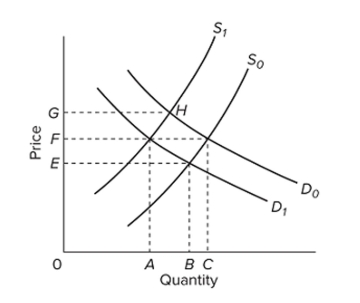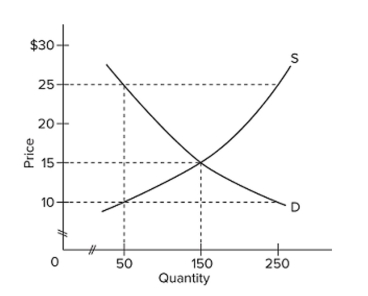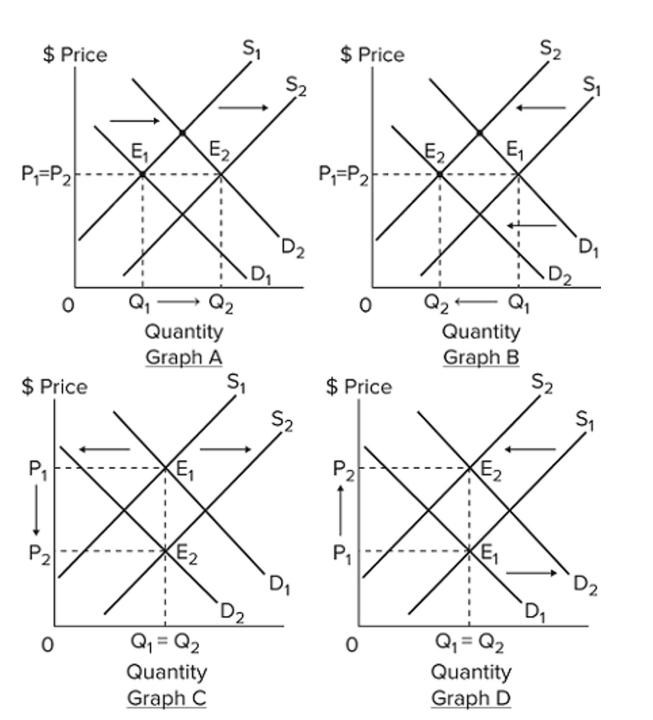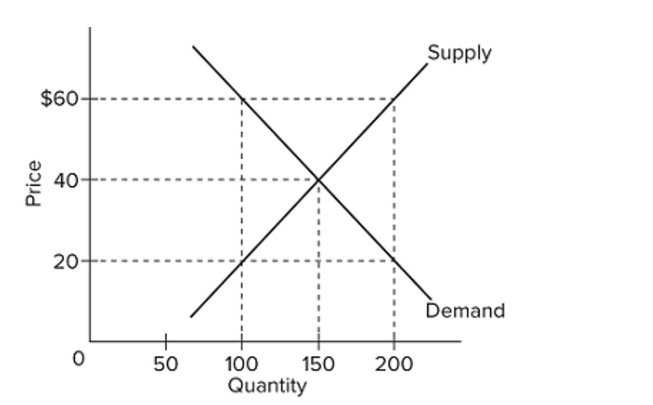A) Price ceilings create surpluses for goods but shortages for services.
B) Price ceilings cause goods to be rationed by some other means than legally determined market prices.
C) Ration coupons are the only way to ration goods when price ceilings are in place.
D) All of these choices are correct.
F) B) and D)
Correct Answer

verified
Correct Answer
verified
Multiple Choice
(Advanced analysis) The demand for commodity X is represented by the equation P = 100 - 2Q and supply by the equation P = 10 + 4Q. The equilibrium price is
A) $50.
B) $70.
C) $80.
D) $130.
F) A) and C)
Correct Answer

verified
Correct Answer
verified
Multiple Choice
The price of pork may increase as a result of
A) a decrease in the cost of feed for pigs.
B) decreased advertising of pork.
C) an increase in the cost of producing beef.
D) a subsidy to pork producers.
F) C) and D)
Correct Answer

verified
Correct Answer
verified
Multiple Choice
(Advanced analysis) The demand for commodity X is represented by the equation P = 10 - 0.2Q and supply by the equation P = 2 + 0.2Q. If demand changes from P = 10 - 0.2Q to P = 7 - 0.3Q, the new Equilibrium quantity is
A) 10.
B) 20.
C) 15.
D) 30.
F) None of the above
Correct Answer

verified
Correct Answer
verified
Multiple Choice
A newspaper reports that the average price of new homes in a certain city had decreased, and the number of new homes sold had also decreased. This situation is probably caused by
A) declining costs of construction materials and services in that city.
B) declining incomes of people in that city.
C) higher government subsidies to new homebuyers in that city.
D) a rising population in that city.
F) B) and D)
Correct Answer

verified
Correct Answer
verified
Multiple Choice
Which of the following will not cause a change in the demand for product A?
A) a change in the number of buyers
B) a change in the price of A
C) a decline in consumer incomes
D) a decrease in the price of close-substitute product B
F) All of the above
Correct Answer

verified
Correct Answer
verified
Multiple Choice
Price floors and ceiling prices both
A) cause shortages.
B) cause surpluses.
C) cause the supply and demand curves to shift until equilibrium is established.
D) interfere with the rationing function of prices.
F) A) and D)
Correct Answer

verified
Correct Answer
verified
Multiple Choice
Which of the following statements is correct?
A) An increase in the price of C will decrease the demand for complementary product D.
B) A decrease in income will decrease the demand for an inferior good.
C) An increase in income will reduce the demand for a normal good.
D) A decline in the price of X will increase the demand for substitute product Y.
F) A) and C)
Correct Answer

verified
Correct Answer
verified
Multiple Choice
An effective price ceiling will
A) induce new firms to enter the industry.
B) result in a product surplus.
C) result in a product shortage.
D) clear the market.
F) C) and D)
Correct Answer

verified
Correct Answer
verified
Multiple Choice
 Refer to the diagram, which shows demand and supply conditions in the competitive market for product X. Given D0, if the supply curve moved from S0 to S1, then
Refer to the diagram, which shows demand and supply conditions in the competitive market for product X. Given D0, if the supply curve moved from S0 to S1, then
A) supply has increased and equilibrium quantity has decreased.
B) supply has decreased and equilibrium quantity has decreased.
C) there has been an increase in the quantity supplied.
D) supply has increased and price has risen to G.
F) A) and C)
Correct Answer

verified
Correct Answer
verified
Multiple Choice
A market is in equilibrium
A) provided there is no surplus of the product.
B) at all prices above that shown by the intersection of the supply and demand curves.
C) if the amount producers want to sell is equal to the amount consumers want to buy.
D) whenever the demand curve is downsloping and the supply curve is upsloping.
F) B) and C)
Correct Answer

verified
Correct Answer
verified
Multiple Choice
If product Y is an inferior good, a decrease in consumer incomes will
A) make buyers want to buy less of Product Y.
B) not affect the sales of product Y.
C) shift the demand curve for product Y to the left.
D) shift the demand curve for product Y to the right.
F) All of the above
Correct Answer

verified
Correct Answer
verified
Multiple Choice
In the following question you are asked to determine, other things equal, the effects of a given change in a determinant of demand or supply for product X upon (1) the demand (D) for, or supply (S) Of, X; (2) the equilibrium price (P) of X; and (3) the equilibrium quantity (Q) of X. An increase in the price of a product that is a complement to X will
A) decrease S, decrease P, and decrease Q.
B) decrease D, decrease P, and decrease Q.
C) increase D, increase P, and increase Q.
D) increase D, increase P, and decrease Q.
F) None of the above
Correct Answer

verified
Correct Answer
verified
Multiple Choice
 In a competitive market illustrated by the diagram above, for a price floor to be effective and alter the market situation, it must be set
In a competitive market illustrated by the diagram above, for a price floor to be effective and alter the market situation, it must be set
A) at $15.
B) below $15.
C) above $15.
D) at $10.
F) B) and C)
Correct Answer

verified
Correct Answer
verified
True/False
A market that is achieving allocative efficiency also is assumed to be achieving productive efficiency.
B) False
Correct Answer

verified
Correct Answer
verified
Multiple Choice
The table below shows the weekly demand for hamburgers in a market where there are just three buyers. If the price of hamburger falls from $5 to $3, then the weekly market quantity demanded will
A) increase from 24 to 52.
B) decrease from 52 to 24.
C) increase from 120 to 156.
D) increase from 29 to 55.
F) All of the above
Correct Answer

verified
Correct Answer
verified
Multiple Choice
Because successive units of a good produce less and less additional satisfaction, the price must fall to encourage a buyer to purchase more units of the good. This statement is most consistent with Which explanation for the law of demand?
A) diminishing marginal utility
B) the rationing function of prices
C) the substitution effect
D) the income effect
F) C) and D)
Correct Answer

verified
Correct Answer
verified
Multiple Choice
In constructing a demand curve for product X,
A) consumer preferences are allowed to vary.
B) the prices of other goods are assumed constant.
C) money incomes are allowed to vary.
D) the supply curve of product X is assumed constant.
F) None of the above
Correct Answer

verified
Correct Answer
verified
Multiple Choice
 Refer to the four graphs above. In which graph would the indicated shifts cause equilibrium quantity to definitely rise, but the effect on price is indeterminate?
Refer to the four graphs above. In which graph would the indicated shifts cause equilibrium quantity to definitely rise, but the effect on price is indeterminate?
A) Graph A
B) Graph B
C) Graph C
D) Graph D
F) A) and C)
Correct Answer

verified
Correct Answer
verified
Multiple Choice
 Refer to the diagram. A price of $20 in this market will result in a
Refer to the diagram. A price of $20 in this market will result in a
A) shortage of 50 units.
B) surplus of 50 units.
C) surplus of 100 units.
D) shortage of 100 units.
F) All of the above
Correct Answer

verified
Correct Answer
verified
Showing 181 - 200 of 357
Related Exams